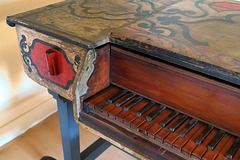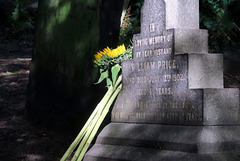MJ Maccardini (trailerfullofpix)'s photos
IMG 1501-001-Handel's Allegro
| |
|
|
|
Fenton House has a number of early keyboard instruments. The collection was amassed by Major Benton Fletcher and includes clavichords, spinets, pianos, harpsichords, and other early keyboards. All are in playable condition, and when the house is open there are often volunteers playing music on them.
IMG 1512-001-Screened Window
| |
|
Looking out one of the upstairs windows at Fenton House. Interestingly, most of the windows are fitted with screens, something you rarely see in Britain.
IMG 1516-001-Garden & Admiral's House
IMG 1518-001-Instrument
| |
|
Fenton House has a number of early keyboard instruments. The collection was amassed by Major Benton Fletcher and includes clavichords, spinets, pianos, harpsichords, and other early keyboards. All are in playable condition, and when the house is open there are often volunteers playing music on them.
IMG 1528-001-Shepherd Statue
| |
|
In the garden at Fenton House. The statue of a shepherd was cast in lead by John Cheere in 1735.
IMG 1510-001-Keyboard
| |
|
Fenton House has a number of early keyboard instruments. The collection was amassed by Major Benton Fletcher and includes clavichords, spinets, pianos, harpsichords, and other early keyboards. All are in playable condition, and when the house is open there are often volunteers playing music on them.
IMG 1511-001-Art & Porcelain
| |
|
In addition to the keyboard instrument collection, Fenton House contains a fine collection of paintings by the Camden Town Group (a personal favourite genre of mine) and Chinese porcelain, which I know nothing about.
IMG 1503-001-Front Walk
| |
|
Looking out one of the upstairs windows at the front walk to Fenton House. Interestingly, most of the windows are fitted with screens, something you rarely see in Britain.
IMG 1496-001-Bolton House
| |
|
|
All the houses around here have names. You can't see them from the street, but I'm sure they are posh. Windmill Hill, Hampstead.
IMG 1494-001-Windmill Hill House
| |
|
All the houses around here have names. You can't see them from the street, but I'm sure they are posh. Windmill Hill, Hampstead.
IMG 1492-001-Enfield House
| |
|
All the houses around here have names. You can't see them from the street, but I'm sure they are posh. Windmill Hill, Hampstead.
IMG 1491-001-George Romney Plaque
| |
|
George Romney (the painter, not the former governor of Michigan) lived here in Holly Bush Hill, Hampstead.
IMG 1484-001-No.9 Holly Place
| |
|
|
Info about the Watch House from the Heath & Hampstead Society's website (with their typos corrected by me):
"On June 19 1829 the Metropolitan Police act was given Royal assent. This placed policing arrangements for the Capital under the control of Sir Robert Peel. Sir Robert organized the force on civilian lines rather than paramilitary. It became the third official non paramilitary police force in the world alongside the City of Glasgow Police and the Paris Police. A blue uniform was chosen rather than red (which was considered a military colour) to reflect the neutral status of the force. Until 1864 the officers wore top hats to maintain a civilian appearance. They were armed solely with a wooden truncheon and a rattle to attract assistance if required. Applicants had to be under the age of 35, in good health and be at least five foot seven inches in height.
Metropolitan Police patrols first took to the streets on 29 September 1829. Some members of the community regarded them as a threat to civil liberties. The original force consisted of 2 Commissioners, 8 Superintendents, 20 Inspectors, 88 Sergeants and 895 Constables, patrolling the streets within a seven-mile radius of Charing Cross. Between 1829 and 1830, 17 local divisions, each with a central police station, were established with each division assigned a letter. Hampstead was division S, and from 1830 officers from the police station in the Watch House at 9 Holly Walk patrolled its streets maintaining public order and combatting crime. After this time prisoners were confined in the Watch House rather than the single cell Parish Lock Up, which was built into the garden wall of 11 Cannon Lane."
Here's a photo of the Parish Lock Up:
IMG 1486-001-Door Knocker
| |
|
|
|
No. 9 Holly Walk, formerly the Watch House, now residential. Rings made of conkers are an autumn thing in this area.
IMG 1485-001-The Watch House
| |
|
Info about the Watch House from the Heath & Hampstead Society's website (with their typos corrected by me):
"On June 19 1829 the Metropolitan Police act was given Royal assent. This placed policing arrangements for the Capital under the control of Sir Robert Peel. Sir Robert organized the force on civilian lines rather than paramilitary. It became the third official non paramilitary police force in the world alongside the City of Glasgow Police and the Paris Police. A blue uniform was chosen rather than red (which was considered a military colour) to reflect the neutral status of the force. Until 1864 the officers wore top hats to maintain a civilian appearance. They were armed solely with a wooden truncheon and a rattle to attract assistance if required. Applicants had to be under the age of 35, in good health and be at least five foot seven inches in height.
Metropolitan Police patrols first took to the streets on 29 September 1829. Some members of the community regarded them as a threat to civil liberties. The original force consisted of 2 Commissioners, 8 Superintendents, 20 Inspectors, 88 Sergeants and 895 Constables, patrolling the streets within a seven-mile radius of Charing Cross. Between 1829 and 1830, 17 local divisions, each with a central police station, were established with each division assigned a letter. Hampstead was division S, and from 1830 officers from the police station in the Watch House at 9 Holly Walk patrolled its streets maintaining public order and combatting crime. After this time prisoners were confined in the Watch House rather than the single cell Parish Lock Up, which was built into the garden wall of 14 Cannon Lane."
Here's a photo of the Parish Lock Up:
IMG 1479-001-John Harrison Tomb
| |
|
His son William's inscription is on the other side of the tomb. This side reads:
“In Memory Of MR. JOHN HARRISON, late of Red-Lion Square, London.
Inventor of the TIME-KEEPER for ascertaining the LONGITUDE at Sea. He was born at Foulby, in the County of York, and was the Son of a Builder at that Place, who brought him up to the same Profession.
Before he attained the Age of 21, He without any Instruction, employed himself in cleaning & repairing Clocks & Watches & made a few of the former, chiefly of Wood. At the Age of 25 He employed his Whole Time in Chronometrical Improvements. He was the Inventor of the Gridiron Pendulum and the Method of preventing the Effect of Heat and Cold upon Time keepers by Two Bars of different Metals fixed together*. He introduced the Secondary Spring to keep them going while winding up; and was the Inventor of most (or all) of the Improvements in Clocks & Watches during his Time.
In the Year 1735, his first Time keeper was sent to Lisbon, and in 1764 his then much Improved fourth Time keeper having been sent to Barbadoes, the Commissioners of Longitude certified that it had determined the Longitude within one Third of Half a Degree of a great Circle, having erred not more than 40 Seconds in Time.
After near fifty years close Application to the above Pursuits, he departed this Life on the 24th Day of March 1776, Aged 83.
MRS. ELIZABETH HARRISON, Wife of the above MR. JOHN HARRISON departed this Life March 5th 1777, Aged 72”
Interestingly, the Harrisons had no connection to Hampstead so it's not clear why they were buried here. It's assumed that the churchyards nearer to Red Lion Square where the family lived were full.
IMG 1478-001-William Harrison Tomb
| |
|
Son of John Harrison (inscription on the other side of the tomb). It reads:
“And to his Son, WILLIAM HARRISON, FRS, born 1728 at Barrow-on-Humber, died 1815. He was the custodian of his father’s prize-winning watch H4 during the vital official trials at sea to Jamaica in 1761, and to Barbados in 1764. He also actively helped his father in the long and difficult negotiations with the Board of Longitude and Parliament when claiming the £20,000 prize. For many years he was a Prominent Governor of the Foundling Hospital, teaching music to the children, and was appointed High Sheriff of Monmouthshire in 1791.”
Interestingly, the Harrisons had no connection to Hampstead so it's not clear why they were buried here. It's assumed that the churchyards nearer to Red Lion Square where the family lived were full.
IMG 1474-001-William Price
Jump to top
- ipernity © 2007-2024
- Help & Contact
|
Club news
|
About ipernity
|
History |
ipernity Club & Prices |
Guide of good conduct
Donate | Group guidelines | Privacy policy | Terms of use | Statutes | In memoria -
Facebook
Twitter


















